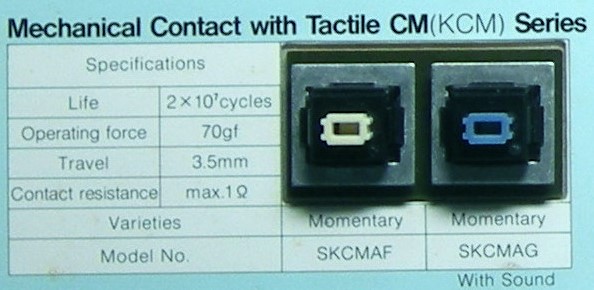Mechanical keyboard
Mechanical keyboard is a term whose meaning is poorly-defined. Different people and organisations use the term for different purposes.
Definitions
Industry usage
Numerous manufacturers describe their switches as "mechanical"; generally, the reason for this is not explained. However, several manufacturers use "mechanical" as way to differentiate different sense methods. ITW and RAFI use the term "mechanical" to differentiate contactless sensing (magnetic valve and Hall effect respectively) from metal contact sensing. General Instrument appear to use "mechanical" to differentiate physically actuated, exposed metal contacts from their typical (magnetically-operated, sealed) reed switches.
In its review of keyboards in the 12th of December 1989 issue, PC Magazine used "mechanical" to refer to metal contact switches.[1] PC Magazine described mechanical switches as follows:
A mechanical key switch—a simple switch relying on contact between two conductive materials—sends a signal through a circuit board to the computer when a key is depressed.
Though the design of such a switch is elementary, the cost can be high, depending on the contact material—often gold or gold alloy—it uses. Mechanical switches are reliable, have a relatively long life expectancy, generate an audible click, and (depending on the spring tension used to return the key) can have a very positive feel. The keyboards we tested from Chicony, DataDesk, NMB, Northgate, and Zeos all use mechanical switches.
In their later keyboard review in the 25th of February 1992 issue, they described mechanical switches as follows:
Mechanical switches are one of the most popular technologies. Keyboards that use mechanical key switches tend to have a positive, tactile touch and generate audible clicks when keys are depressed. The feel and sound result from the contact that occurs between conductive materials on the plunger; the conductors are often made of gold, gold alloy, or mylar with silver-carbon overlay.
Some membrane keyboards (notably from Lexmark and Tandy) use mechanical spring actuators as the mechanism in the keys but a different technology to close the electrical connection. This allows them to retain the solid feel of mechanical switches without compromise; you won't confuse these with keyboards that try to imitate mechanical switches by adding electronic clicks.
One problem with mechanical switches is the number of parts required. A mechanical-switch keyboard may use as many as three times the parts of a membrane-switch model. Cherry, Chicony, DataDesk, NMB, and Northgate supplied mechanical switch models.
Here, they are already blurring the line between "mechanical" referring to metal switch contacts, and "mechanical" referring to having a mechanism of some kind, regardless of the switch contacts. Nonetheless, they listed the IBM Enhanced Keyboard as "membrane", and as using "IBM's implementation of membrane switches".[2]
Although this later definition no longer incorrectly requires all "mechanical" switches to be clicky (although in most consumer keyboards they were), the introduction of the possibility of mylar contacts in a mechanical switch seems strange. Also, the description of where the sound comes from seems to be derived from inspecting a Cherry switch, having never examined any other brands of switch.
Lay usage
Arguably the best-known "mechanical" keyboard (at least, in lay usage) is the IBM Enhanced Keyboard, colloquially known as the IBM Model M. Model M keyboards are membrane keyboards and would not fit well into the definition of "mechanical" denoting metal contacts. "Mechanical" has also been applied to Topre switches, which do not use metal contacts.[Citation needed]
As such, the term "mechanical" gets used to categorize keyboards with high quality switches, regardless of the technology. This would imply that cheaply-made and unreliable metal contact keyboards should be excluded from being classed as "mechanical", which risk creating more confusion instead of less.
The term is sometimes defined as a keyboard that uses a switching mechanism which makes use of some sort of metal spring (thus including the IBM Model M), or a switch that actuates at some point before the end of the switch's travel. These definitions are somewhat meaningless, given the huge variation in quality across different switch designs that have these properties. Consequently, some people prefer to use terms such as "high quality keyboards", or to refer to the keyboards by their specific switch type.[3]
Examples
Products described as "mechanical" or "mechanical contact" include:
- Alps SKCL/SKCM series
- Alps SKBL/SKBM series ("High-reliability mechanical contact." on the Forward Electronics website in 2004)
- General Instrument Series S950
- ITW magnetic valve second generation is defined in the patent as supporting either analogue magnetic sensing, or "mechanical" contacts
- Monterey K110 keyboard and KP110 keypad, per the 1992 Monterey catalogue
- Omron B3G series, as 「メカキースイッチ」 ("Mechanical key switch"), per Omron literature
- RAFI RS 74 M, RS 76 M ("M" for mechanical, compared to RAFI RS 74 C and RS 76 C contactless switches, "C")
- SMK J-M0404 series (in the SMK J-M9031 keyboard specifications)
- Tokai MM9 series
Alps SKCM Blue and Alps SKCM Cream were marketed by Alps as "mechanical contact" in the 1980s:
References
- ↑ Google Books — PC Magazine, December 12, 1989 (Wanted: More Than Just a Replacement, p. 225–260)
- ↑ Google Books — PC Magazine, February 25, 1992 (The Write Stuff, pp. 303–329)
- ↑ Deskthority — We need a better adjective than "mechanical".
